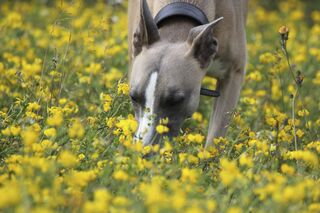We are ready to accept animal supremacy in anatomical features or physical performances: Many species are bigger, stronger, or faster than humans and we of course accept that these are adaptations shaped by evolution.
Interestingly, however, we have problems imagining that animals could also outperform us in cognitive abilities. As a result, we tend to overrate those cognitive skills that are human-like and fall into a trap that can be scientifically even more fatal: we run the risk of overlooking cognitive skills that play only a minor role or no role in human psychology (Bräuer et al 2020).
There are some individual animals that are famous for their outstanding cognitive skills: the dog Rico who could label more than 200 objects using a learning mechanism for new items similar to human children (Kaminski at al 2004), the grey parrot named Alex that acquired a verbal vocabulary consisting of color adjectives, shapes and numbers (Pepperberg, 1999) and the chimpanzee Ayumo who outperformed human students in a working memory task ordering Arabic numerals (Inoue & Matsuzawa, 2007).
But it's not only individuals that sometimes outperform humans; in some tasks, humans generally perform worse than animals. For example, humans have been described as exceptionally patient. This is considered evolutionarily adaptive: forgoing immediate benefits to acquire more valuable future rewards. But human patience drastically decreases when the relevant currency is food instead of money. In particular, humans are less willing to wait for food rewards than chimpanzees (Rosati et al 2007)!
But our closest living relatives aren’t the only ones who outperform us in some cognitive tasks. Pigeons are famously able to distinguish between Monet and Picasso paintings after some period of training (see Emery, 2006 for a review) — I cannot do that. Humans are also outperformed in spatial memory tasks. Some bird species like Clark’s nutcracker and the marsh tit are able to remember over 100 cache sites after time delays of several months, which exceeds the average human memory skills by far (Balda & Kamil, 1992; Urhan, Emilsson, & Brodin, 2017).

If we really want to understand animal cognition, we have to take new approaches. For example, if we want to understand what dogs “think," then we not only need to test them in cognitive domains humans are good at but also in domains that are relevant to them. Nearly all we know about dog cognition is based on their performance in the visual or auditory modality, even though there is no doubt that olfaction (the sense of smell) is the most relevant sense that dogs use to explore their environment. That is why, together with my colleagues, I investigate how dogs perceive and process a scent. For example, when a dog follows a scent trail of his or her owner, does s/he simply perceive it as a "good" (i.e. relevant) track that is worth following? Or does the dog have a precise expectation of who will be at the end of the track? It is not so easy to investigate this because I myself cannot perceive this trail at all. We just published a study in Scientific Reports showing that dogs indeed seem to have that precise expectation. When we secretly replaced one owner with the other owner at the end of the trail, the dogs were not satisfied with meeting the other – equally beloved – person. Rather, they showed increased activity, indicating that they were looking for the specific person who corresponded to the track. Together with other findings, our study suggests that dogs have a flexible representation of what they smell (Bräuer & Blasi 2021).
Thus, we might really underestimate some animal cognitive skills simply because we ourselves are not good at them. It is not unlikely that one day soon we’ll find out that dogs not only know who exactly is on the end of the trail but also what mood he or she is in (D`Aniello et al 2018).
References
Balda, R. P., & Kamil, A. C. (1992). Long-term spatial memory in clark's nutcracker, Nucifraga columbiana. Animal Behaviour, 44(4), 761-769.
Bräuer, J., Hanus, D., Pika, S., Gray, R., & Uomini, N. (2020). Old and New Approaches to Animal Cognition: There Is Not "One Cognition". J Intell, 8(3).
Bräuer, J., & Blasi, D. (2021). Dogs display owner-specific expectations based on olfaction. Scientific Reports, 11(1), 3291.
D’Aniello, B., Semin, G. R., Alterisio, A., Aria, M., & Scandurra, A. (2018). Interspecies transmission of emotional information via chemosignals: from humans to dogs (Canis lupus familiaris). Animal Cognition, 21(1), 67-78.
Emery, N. J. (2006). Cognitive ornithology: the evolution of avian intelligence. Philosophical Transactions of the Royal Society B: Biological Sciences, 361(1465), 23-43.
Inoue, S., & Matsuzawa, T. (2007). Working memory of numerals in chimpanzees. Current Biology, 17(23), R1004-R1005.
Kaminski, J., Call, J., & Fischer, J. (2004). Word learning in a domestic dog: Evidence for "Fast Mapping". Science, 304(5677), 1682-1683.
Pepperberg, I. M. (1999). The Alex Studies: Cognitive and communicative abilities of grey parrots Cambridge, MA, US: Harvard University Press.
Rosati, A. G., Stevens, J. R., Hare, B., & Hauser, M. D. (2007). The evolutionary origins of human patience: Temporal preferences in chimpanzees, bonobos, and human adults. Current Biology, 17(19), 1663-1668.
Urhan, A. U., Emilsson, E., & Brodin, A. (2017). Evidence against observational spatial memory for cache locations of conspecifics in marsh tits Poecile palustris. Behavioral Ecology and Sociobiology, 71(2), 34.


